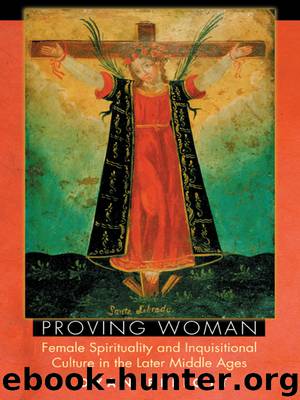Proving Woman by Dyan Elliott

Author:Dyan Elliott
Language: eng
Format: epub
Publisher: Princeton University Press
Published: 2009-04-12T04:00:00+00:00
Chapter Five
Between Two Deaths: The Living Mystic
When, therefore, it is asked whether [Francis] is of greater merit because he has the stigmata rather than the
crown of the martyr, Isay that if there were to be a comparison
with respect to the person, Iso believe that [the stigmata]
were a greater sign of merit and prerogative than
if he had had martyrdom. . . . for [martyrdom] is common to many, but [the stigmata] to none.
(Anonymous)
Iunderstood that St. John had endured such great sorrow
over the passion of Christ and over the sorrows of
the mother of Christ that Iwas convinced, and still am, that
he is more than a martyr.
(Angela of Foligno, d. 1309)
“Mother Iam dead.” And the other, pierced through, answered: “Woe is me, daughter, what are you
The Virgin answered: “Mother, Iam entirely dead.” saying?”
(Giacomo Scalza, The Life of Vanna
d’Orvieto, d. 1306)1
THE DEAD HERETIC had gained the field as the martyr, something that ecclesiastical authorities seemed to acknowledge by tacitly ceding this ground. The passing of the orthodox martyr corresponded to the rise of the living saint—an individual who made the expression “dead to the world” vibrate with new meaning. Indeed, the fact that the anonymous Franciscan quoted above will actually argue the superiority of the stigmata over physical martyrdom demonstrates just how successfully orthodoxy had negotiated this transition. Angela of Foligno’s parallel reasoning demonstrates her quick assimilation of the martyr’s demotion.
Both James of Vitry and Thomas of Cantimpré, two of the clerical masterminds in redirecting orthodox conceptions of martyrdom, had laid claim to the indeterminate gray zone between two deaths on behalf of their holy clients. But such claims were voiced only after the individuals in question were dead. Proving that a living person had already entered that middle place in between was a delicate, and even hazardous, task. It was dangerous, and potentially heretical, to venerate someone as a saint while that person was still alive.2 This stark fact brings the possible obstacles confronted by the promoters of a living saint immediately into sharp focus. Moreover, papal canonization had established a new evidentiary standard that required careful planning on the part of a holy client’s sponsors, and this planning generally had to begin long before the putative saint’s death. Evidence of a virtuous life needed to be chronicled, miracles during his or her lifetime needed to be witnessed by others and duly recorded, revelations needed to be transcribed, and the individual’s fama as holy needed to be carefully disseminated. If the center of a putative cult was not a self-abnegating princess (like Elisabeth of Hungary), a saintly crusading king (like Louis IX, d. 1270), an angelic pope (like Celestine V), or a pious bishop (like Thomas of Cantilupe, d. 1282), but simply a lowly layperson who had no access to automatic visibility by virtue of his or her estate, the promotion would be infinitely more difficult.3
The inquisitional procedure would perform a critical function in providing these proofs, even though, for a number of reasons, this role is not always as apparent as might be expected.
Download
This site does not store any files on its server. We only index and link to content provided by other sites. Please contact the content providers to delete copyright contents if any and email us, we'll remove relevant links or contents immediately.
The Gnostic Gospels by Pagels Elaine(2399)
Jesus by Paul Johnson(2229)
Devil, The by Almond Philip C(2205)
The Nativity by Geza Vermes(2115)
The Psychedelic Gospels: The Secret History of Hallucinogens in Christianity by Jerry B. Brown(2073)
Forensics by Val McDermid(1979)
Going Clear: Scientology, Hollywood, and the Prison of Belief by Lawrence Wright(1884)
Going Clear by Lawrence Wright(1873)
Barking to the Choir by Gregory Boyle(1729)
Old Testament History by John H. Sailhamer(1713)
Augustine: Conversions to Confessions by Robin Lane Fox(1686)
The Early Centuries - Byzantium 01 by John Julius Norwich(1655)
A History of the Franks by Gregory of Tours(1637)
The Bible Doesn't Say That by Dr. Joel M. Hoffman(1608)
Dark Mysteries of the Vatican by H. Paul Jeffers(1606)
A Prophet with Honor by William C. Martin(1603)
by Christianity & Islam(1562)
The First Crusade by Thomas Asbridge(1539)
The Amish by Steven M. Nolt(1490)
